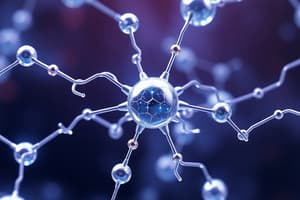Podcast
Questions and Answers
What is one example of a molecule with an angular shape?
What is one example of a molecule with an angular shape?
- CH4
- NH3
- H2O (correct)
- BI3
What type of molecular shape does ammonia (NH3) have?
What type of molecular shape does ammonia (NH3) have?
- Trigonal pyramidal
- Trigonal planar (correct)
- Linear
- Tetrahedral
In the molecule BI3, what is the central atom?
In the molecule BI3, what is the central atom?
- Oxygen
- Boron (correct)
- Iodine
- Hydrogen
Does BI3 have any lone pairs around its central atom?
Does BI3 have any lone pairs around its central atom?
What is the general formula for the molecule BI3?
What is the general formula for the molecule BI3?
What bond angle does ammonia (NH3) have?
What bond angle does ammonia (NH3) have?
What is the molecular shape of BI3?
What is the molecular shape of BI3?
Which of the following molecules has a pyramidal shape?
Which of the following molecules has a pyramidal shape?
Identify a non-ideal shape from the given options.
Identify a non-ideal shape from the given options.
Which type of shape is considered ideal for the molecule BI3?
Which type of shape is considered ideal for the molecule BI3?
Flashcards are hidden until you start studying
Study Notes
Here are the study notes:
Chemical Bonding
- Chemical bonds are formed when atoms approach each other and the electrostatic forces of attraction and repulsion are balanced
- A chemical bond exists when the attractive and repulsive forces are balanced
- The "rule of two" states that a chemical bond involves the formation of electron pairs, known as a bonding pair
Bond Formation and Stability
- As atoms approach each other, the potential energy within the system decreases
- At a critical point, the potential energy will be at its lowest when the electrostatic attractive and repulsive forces are balanced
- This is when the combination is at its most stable
- The distance between the nuclei of each atom is now fixed, known as the bond length
Bonding
- He atoms do not bond because they have a full valence shell and cannot undergo bond formation
- Lewis diagrams can show combinations of different atoms
- A lone pair is a pair of electrons that are not involved in chemical bonding
- A bonding pair is a pair of electrons that are formed when a chemical bond is formed
- Lone pairs do not make chemical bonds
- The dative covalent bond is a special covalent bond formed from a lone pair
Multiple Bonding
- More than one bonding pair can be formed between the same atoms
- This leads to the formation of double and triple bonds
- Examples: O₂ (double bond), N₂ (triple bond), and HCN (triple bond)
Dative Covalent Bond
- The dative covalent bond must be shown using NH₃⁺ and H₂O as examples
- An atom with an empty valence shell is able to share a lone pair from another atom
- The atom with the empty valence shell is usually a hydrogen atom
- NH₃ and H₂O have lone pairs and are able to "share" a lone pair
Intermolecular Forces
- Intermolecular forces are the forces of attraction and repulsion between atoms or ions within a chemical bond
- There are three types of chemical bonds: covalent, ionic, and metallic
Atomic Combinations - Molecular Structure
- Chemical bonds within a chemical substance play a significant role in chemical and physical properties
- There are different types of chemical bonds: covalent, ionic, and metallic
- Covalent bonds occur between non-metal atoms through electron sharing
- Ionic bonds occur between a metal atom and a non-metal atom through electron transfer
- Metallic bonds occur between metal atoms through electrostatic forces of attraction
Molecular Shapes
- Molecules exist in three-dimensional space with different shapes depending on the arrangement of the atoms and number of bonds
- This is explained through VSEPR theory
- Repulsive forces exist between electron pairs that are present in the valence shells after bonding
- These repulsive forces cause stress within the molecule, making electron pairs repel each other as far away as possible to minimize the stresses
- Molecules wish to be in the lowest, most stable energy state
Ideal Shapes
- Ideal shapes are based on a central atom with no lone pairs surrounding them
- There are five ideal shapes: linear, trigonal planar, tetrahedral, trigonal bipyramidal, and octahedral
Non-Ideal Shapes
- Non-ideal shapes have lone pairs of electrons on the central atoms
- Examples: angular (H₂O) and pyramidal (NH₃)
I hope these notes help! Let me know if you have any questions.
Studying That Suits You
Use AI to generate personalized quizzes and flashcards to suit your learning preferences.




